A trope in modern fantasy/science fiction is the idea of a central language (often called The Speech) that is the root of all languages, and in some cases the true describing words that made the universe.
Unifying characteristics of this language in many books include:
A popular example of this is found in the Young Wizards series of novels by Diane Duane. All creatures and things understand and, to a degree, can speak the Speech intuitively, but specifically, it is the wizards who use it as their primary language and means of performing their works of magic. It is incredibly detailed and describes things that other languages cannot. Describing something inaccurately in the Speech may result in catastrophic effects (including changing the nature of the thing or being therein misdescribed); therefore, wizards are advised to never curse or lie in the Speech. Spells are described in the Speech; the wizard tells the object/subject what he/she wants to happen to it. With a final word, the spell can be let loose to do what it was supposed to do.
The written characters of "The Speech" are described in several of the books as resembling Arabic, and in Deep Wizardry, Nita's father mistakes the writing on the title page of Nita's Manual for Arabic letters.
Other examples:

A Wizard of Earthsea is a fantasy novel written by American author Ursula K. Le Guin and first published by the small press Parnassus in 1968. It is regarded as a classic of children's literature, and of fantasy, within which it was widely influential. The story is set in the fictional archipelago of Earthsea and centers on a young mage named Ged, born in a village on the island of Gont. He displays great power while still a boy and joins the school of wizardry, where his prickly nature drives him into conflict with one of his fellows. During a magical duel, Ged's spell goes awry and releases a shadow creature that attacks him. The novel follows his journey as he seeks to be free of the creature.
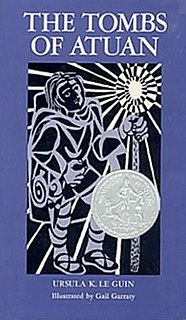
The Tombs of Atuan is a fantasy novel by the American author Ursula K. Le Guin, first published in the Winter 1970 issue of Worlds of Fantasy, and published as a book by Atheneum Books in 1971. It is the second book in the Earthsea series after A Wizard of Earthsea (1969). The Tombs of Atuan was a Newbery Honor Book in 1972.
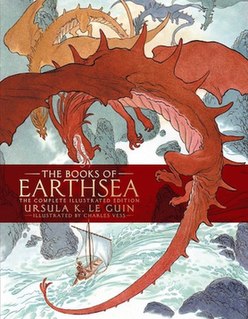
The Earthsea Cycle, also known as Earthsea, is a series of high fantasy books written by the American writer Ursula K. Le Guin. Beginning with A Wizard of Earthsea (1968), The Tombs of Atuan, (1970) and The Farthest Shore (1972), the series was continued in Tehanu (1990), and Tales from Earthsea and The Other Wind. In 2018, all the novels and short stories were published in a single volume, The Books of Earthsea: The Complete Illustrated Edition, with artwork by Charles Vess.

The Sword of Truth is a series of twenty-one epic fantasy novels written by Terry Goodkind. The books follow the protagonists Richard Cypher, Kahlan Amnell, Nicci, Cara, and Zeddicus Zu'l Zorander on their quest to defeat oppressors who seek to control the world and those who wish to unleash evil upon the world of the living. While each novel was written to stand alone, except for the final three that were intended to be a trilogy, they follow a common timeline and are linked by ongoing events that occur throughout the series.
In J. K. Rowling's Harry Potter series, magic is depicted as a supernatural force that can be used to override the usual laws of nature. Many fictional magical creatures exist in the series, while ordinary creatures also sometimes exhibit magical properties. Magical objects are also described. The small number of humans who are able to perform magic refer to the rest of the population, oblivious to the existence of magic, as "Muggles" in the United Kingdom and "No-Maj" in the United States.

The Farthest Shore is a fantasy novel by the American author Ursula K. Le Guin, first published by Atheneum in 1972. It is the third book in the series commonly called the Earthsea Cycle. As the next Earthsea novel, Tehanu, would not be released until 1990, The Farthest Shore is sometimes referred to as the final book in the so-called Earthsea trilogy, beginning with A Wizard of Earthsea. The events of The Farthest Shore take place several decades after The Tombs of Atuan and continue the story of the wizard Ged.

Tehanu, initially subtitled The Last Book of Earthsea, is a fantasy novel by the American author Ursula K. Le Guin, published by Atheneum in 1990. It is the fourth novel set in the fictional archipelago Earthsea, following almost twenty years after the first three Earthsea novels (1968–1972), and not the last, despite its subtitle. It won the annual Nebula Award for Best Novel and the Locus Award for Best Fantasy Novel.
"The Rule of Names" is a short story by American writer Ursula K. Le Guin, first published in the April 1964 issue of Fantastic, and reprinted in collections such as The Wind's Twelve Quarters. This story and "The Word of Unbinding" convey Le Guin's initial concepts for the Earthsea realm, most importantly its places and physical manifestation, but not most of the characters appearing in the novels, other than the dragon Yevaud. Both stories help explain the underpinnings of the Earthsea realm, in particular the importance of true names to magic.
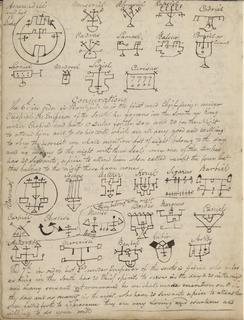
An incantation, a spell, a charm, an enchantment or a bewitchery, is a magical formula intended to trigger a magical effect on a person or objects. The formula can be spoken, sung or chanted. An incantation can also be performed during ceremonial rituals or prayers. In the world of magic, wizards, witches, and fairies allegedly perform incantations.

The magic in Dungeons & Dragons consists of the spells and magic systems used in the settings of the role-playing game Dungeons & Dragons (D&D). D&D defined the genre of fantasy role-playing games, and remains the most popular table-top version. Many of the original concepts have become widely used in the role-playing community across many different fictional worlds, as well as across all manner of popular media including books, board games, video games, and films.
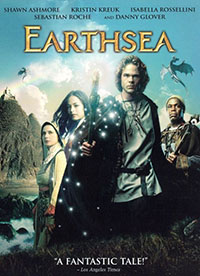
Legend of Earthsea is a two-part television fantasy miniseries produced for the Sci-Fi Channel. It is an adaptation of the Earthsea novels by Ursula K. Le Guin. The teleplay was written by Gavin Scott, and the series was directed by Robert Lieberman. It was an American-Canadian co-production, filmed on-location in Vancouver, British Columbia.
A true name is a name of a thing or being that expresses, or is somehow identical to, its true nature. The notion that language, or some specific sacred language, refers to things by their true names has been central to philosophical study as well as various traditions of magic, religious invocation and mysticism (mantras) since antiquity.
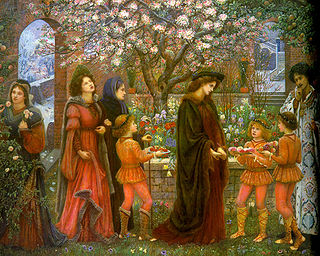
A magician, also known as a enchanter/enchantress, mage, magic-user, sorcerer/sorceress, spell-caster, warlock, witch, or wizard, is someone who uses or practices magic derived from supernatural, occult, or arcane sources. Magicians are common figures in works of fantasy, such as fantasy literature and role-playing games, and enjoy a rich history in mythology, legends, fiction, and folklore.

Inheritance is a 2011 novel written by American author Christopher Paolini. It is the fourth novel in The Inheritance Cycle.
Elvish languages are constructed languages used by Elves in a fantasy setting.

A Wizard of Mars is the ninth novel in the Young Wizards series by Diane Duane. After being pushed back several times due to internal turmoil at Harcourt Trade Publishers, it was scheduled to be released April 14, 2010, but the distributor shipped it in late March.
Ged is the true name of a fictional character in Ursula K. Le Guin's Earthsea realm. He is introduced in A Wizard of Earthsea, and plays both main and supporting roles in the subsequent Earthsea novels. In most of the Earthsea books he goes by the Hardic name Sparrowhawk.
Earthsea is a fictional world originally created by Ursula K. Le Guin for her short story "The Word of Unbinding", published in 1964. Earthsea became the setting for a further six books, beginning with A Wizard of Earthsea, first published in 1968, and continuing with The Tombs of Atuan, The Farthest Shore, Tehanu, Tales from Earthsea and The Other Wind. Nine short stories by Le Guin are also set in Earthsea; the earliest two in her 1975 collection of short stories The Wind's Twelve Quarters, five in Tales from Earthsea, and the final two in an illustrated collection in The Books of Earthsea. Collectively, the series is simply known as Earthsea.
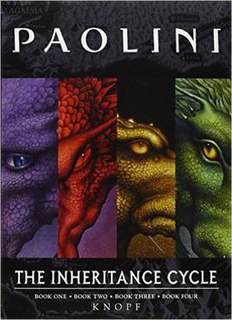
The Inheritance Cycle is a tetralogy of young adult high fantasy novels written by American author Christopher Paolini. Set in the fictional world of Alagaësia, the novels focus on the adventures of a teenage boy named Eragon and his dragon, Saphira, as they struggle to overthrow the evil king Galbatorix. The series was originally intended to be a trilogy until Paolini announced on October 30, 2007, while working on the third novel, that he believed the story was too complex to conclude in just three books.